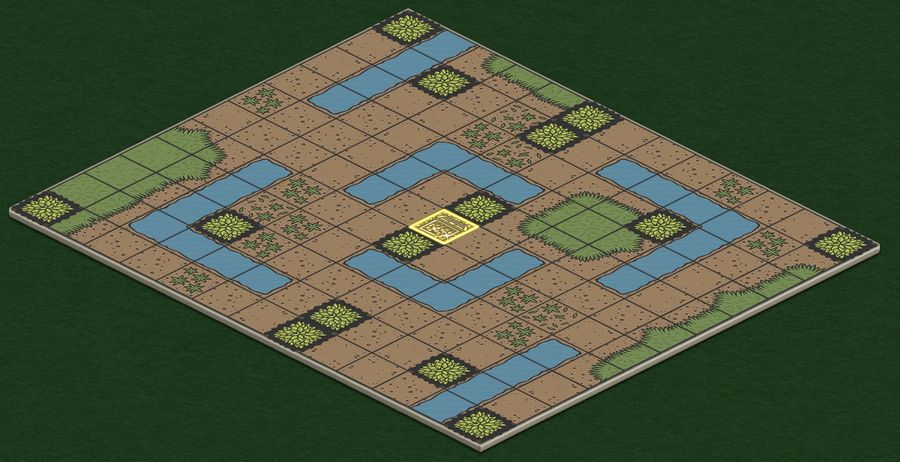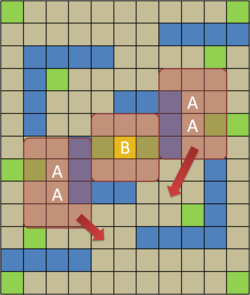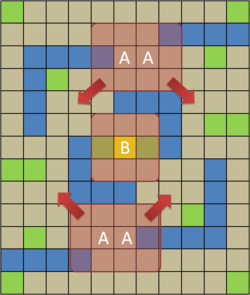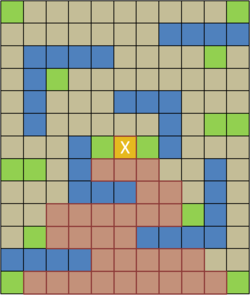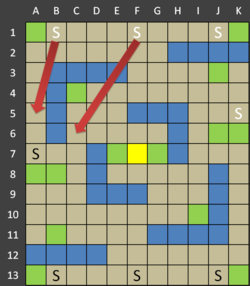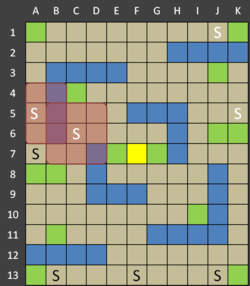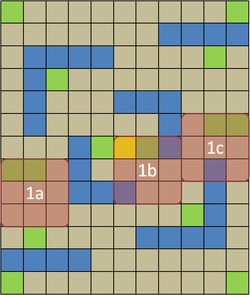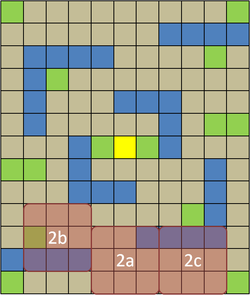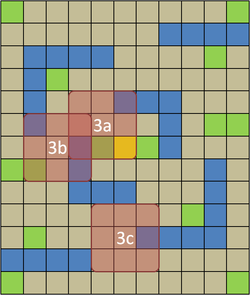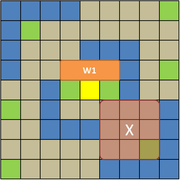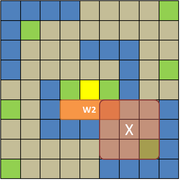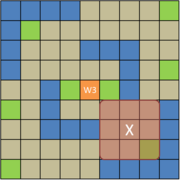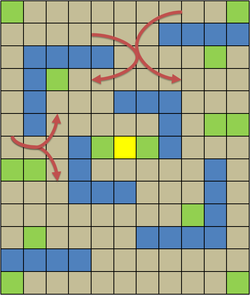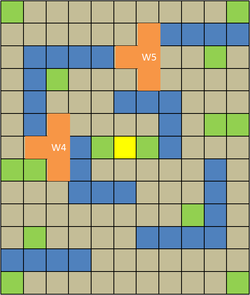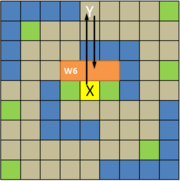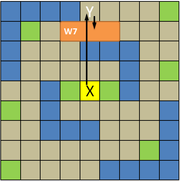Streams of Blood (Ranked)
| Line 1: | Line 1: | ||
==Streams of Blood Map Analysis== | ==Streams of Blood Map Analysis== | ||
| − | [[File:Streams of Blood.jpg|center|900px]] | + | [[File:Streams of Blood.jpg|thumb|center|900px|Streams of Blood PvP map]] |
| − | {| cellspacing="0" cellpadding="0" | + | {| cellspacing="0" cellpadding="0" style="margin-left: auto; margin-right: auto;" |
|- | |- | ||
| valign="top" width="50%" | | | valign="top" width="50%" | | ||
| Line 36: | Line 36: | ||
| align="center"| 97 | | align="center"| 97 | ||
|} | |} | ||
| + | |- | ||
| + | |colspan=2 | <span style="font-size:85%"> ''Open terrain analysis: For each open terrain, count the number of adjacent open terrains. An open terrain has a minimum of 1 adjacent open terrain and a maximum of 8 open terrains. <br /> The quantity signifies the number of open terrains with X adjacent open terrains. The distribution indicates the map difficulty in relation to movement.'' </span> | ||
|} | |} | ||
| − | |||
| − | |||
| − | |||
| − | |||
==Offensive Map Control== | ==Offensive Map Control== | ||
Revision as of 19:15, 21 May 2013
Contents |
Streams of Blood Map Analysis
|
| ||||||||||||||||||||||||||||||||||
| Open terrain analysis: For each open terrain, count the number of adjacent open terrains. An open terrain has a minimum of 1 adjacent open terrain and a maximum of 8 open terrains. The quantity signifies the number of open terrains with X adjacent open terrains. The distribution indicates the map difficulty in relation to movement. | |||||||||||||||||||||||||||||||||||
Offensive Map Control
Choke Points and Pincers
| Streams of Blood (SoB) is a PVP map containing 143 terrains with 1 victory terrain. There are no difficult terrains but a variety of narrow restrictive paths and four dead ends make SoB perilous to the unwary. All figures adopt the 'offensive force attacking downwards and opponent defending upwards' orientation. Narrow paths give rise to choke points and kill zones, forcing your opponent to seek meager cover provided by blocked terrains. Figs. 1 and 2 show the positions of various choke points in the map labelled as A and B. By occupying the various strategic points, opposing units are forced to fight on multiple fronts. Gradual pincer movements (as illustrated by the red arrows) squeeze the available pockets and entrap opposing units, making for quick easy kills. The primary difference between Figs. 1 and 2 lie in the victory terrain at B. When the map is split vertically, occupying B reduces the effectiveness of the choke point and pincer movement due to restricted line of sight. It can however be utilized as an ambush point for burst units equipped with Charge and step based attacks. Against the AI, SoB favors Amy's party of elves due to their natural Dash moves. An early Rockfall/Cave In combined with critical positioning and offensive attacks make short work of any party. |
Line of Sight
| Due to the lack of open terrains, line of sight is a precious commodity crucial for ranged units in SoB. As Fig. 3 shows, a unit represented by X occupying the victory terrain can see 58 open terrains fore and aft providing much needed firepower and support for melee units. For a map containing 97 open terrains, this represents more than half the map. In addition, the unit occupying X can take a step forward and increase its forward line of sight coverage while leaving the victory terrain in close proximity for easy recapture, an advantage easily exploitable via Dimensional Traveller. This makes the victory terrain a great spot to hold, defend, attack and support from. In the event that the victory terrain is already occupied, an alternative position that provides excellent line of sight is represented by X as shown in Fig. 4. This position provides a line of sight of 40 open terrains for the offensive force attacking downwards. Utilizing map symmetry, it is possible to install another ranged unit on the opposite side of the map, giving complete map coverage using only ranged units. Note that the effectiveness of these positions are highly dependent on possession of the victory terrain. If the victory terrain is in enemy hands, the opponent could simply use pincers (as shown in Fig. 2) to eliminate X. Be especially prudent and wary in capturing critical spots. |
Rush Tactics
|
While a blitz is designed to break a holding formation or a defensive line, a rush uses speed and surprise to overwhelm and/or cripple an enemy before they achieve effective buildup. The primary objective is to reduce the opponent's effectiveness as early as possible. A rush is nowhere as effective mid/late game, hence, the emphasis on speed and surprise. In SoB, there are two viable rush tactics: rushing the spawn point and rushing the victory terrain. |
Defensive Map Control
Defensive Positioning
| Defensive map control is a risk averse approach to the game. It maximizes a party's effectiveness in combat through synergy and unit positioning, preventing flanking maneuvers and countering offensives. A basic tactic of defensive map control is defensive positioning utilizing available terrains, blind spots and ambush points to shut down the enemy. In SoB, the number of blocking terrains allow for easy defensive positioning both for melee and ranged units. 1a & 1c: Camping points for side lanes. Units attempting to flank or pincer (from the top) are slowed and vulnerable. Anvil Strikes become extremely deadly. Limited line of sight for ranged enemies. Combined with ranged support from 1b, these defensive positions form vertical pincers. 1b: Camping point for mid lane and victory square. Excellent spot behind cover that allows for multi-directional offensives, support and counters. Also useful for sniping victory square. Useful cards in hand to exert area of influence: Bashes, Force Bolts etc. 2a & 2b: Useful spots for ranged units to cover and attack enemy units attempting to infiltrate from the tri-lanes. Large field of view with overlaps, creating kill zones. Long range attacks combined with AOEs shut down enemy maneuvers. 2c: Sniper's spot, considered inferior to 2a & 2b as the range requirement is longer and does not provide alternative for advance. Combines well with Surging Bolts and Surging Blasts. |
Blitzkrieg
|
Blitzkrieg refers to a strategy that employs concentrating overwhelming force at high speed to break through enemy lines. In SoB, while offensive map control shuts down a party effectiveness quickly, it tends to spread units out due to multiple lane pockets. The defending party can choose to focus all attacks and blitz a single lane, thereby throwing the opponent into disarray. The blitz is also useful in creating lane pressure, forcing enemy units into giving up precious positions. |
Crowd Control
Crowd control (CC) is a term used in MMORPGs (Massive Multiplayer Online Role-Playing Games) and MOBA (Multiplayer Online Battle Arena) games to refer to the ability to limit the number of mobs actively fighting during an encounter. It also refers to abilities that influence or prevent the abilities or actions of other character(s). Crowd control is extremely powerful as it forces opponents to use a smaller set of abilities/actions, rendering an opponent nearly useless. In Card Hunter, CC is neither an offensive or defensive strategy. Instead it belongs in its own category and merits a separate discussion. In the context of a pvp map guide, we focus on terrain based forms of CC and present two useful examples centered around Wall of Stone and Wall of Illusion.
Wall of Stone (WoS)
Wall of Stone introduces up to three blocking terrains for a duration of two turns. SoB is a great map for WoS. The narrow restrictive paths and dead ends make it easy to shut down lanes, areas and cut off retreat routes. The most obvious being the area around the victory terrain. Figs. 11, 12 and 13 show zoomed-in illustrations of the various uses.
|
W1 & X: W1 represents a WoS casted to deny units entering/leaving the victory terrain. The unit at X can either engage an enemy in the side lanes or choose to snipe the victory terrain for points. This is an offensive CC use of Wall of Stone. |
|
Aside from using WoS in the area around the victory terrain, SoB allows for many other places where WoS can be applied creatively. If we study the flow of movement as shown in Fig. 14, units (without Teleport) must traverse certain key areas in order to engage the enemy. Due to map symmetry, due diligence in applying WoS can effectively isolate pockets of terrain that prevent enemies from fleeing/retreating and/or allow for defensive stalls and unit protection. |
Wall of Illusion (WoI)
Wall of Illusion introduces up to three terrains designed to block enemy's line of sight for a duration of one turn. While not as useful or as easy to use as WoS, WoI is a great way to create a zone of protection by blocking line of sight. In a similar regard, the most useful area for WoI is the area around the victory terrain. Figs. 16, 17 and 18 show zoomed-in illustrations.
|
Figure 16 show a unit at X and an enemy at Y with bi-directional line of sight (denoted by the black arrows). When WoI is casted at the area denoted by W6 (Fig. 17), X now has line of sight to Y but Y does not have line of sight to X. X is therefore protected from attacks by Y while having the ability to attack Y without retaliation. In fact, due to W6, X is entirely protected from targeted attacks anywhere in the top half of the map. With the exception of Whirlwind and Whirlwind Enemies, X has effectively scored a victory point while ensuring maximum line of sight upon the enemy. This is a defensive CC use of WoI. |
|
Where WoS impedes movement flow, WoI impedes field of view. As Figs. 3 and 4 above shows, maximum line of sight is obtained when units are localized at the center of the map near the tri-lane pockets. However, these positions are restrictive and narrow. Well-timed use of WoI (W8, W9) effectively shuts down the opponent's party effectiveness, making the tri-lanes a dangerous place for the unwary. |
Credits
Phaselock: Author of this guide.
Lance: Proofread this guide. I really appreciated it. :)
